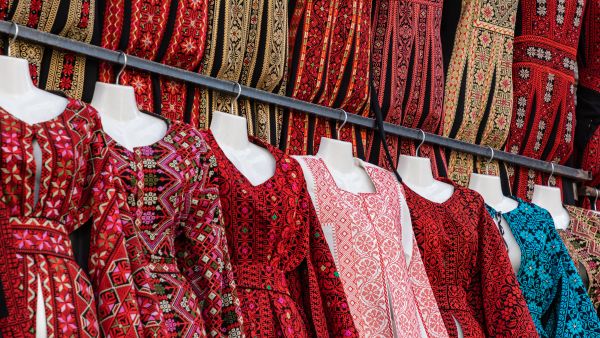ALBAWABA - The Jordanian thobe, also known as the national dress, holds a significant place in the cultural heritage of Jordan. This report explores the development and evolution of the Jordanian thobe throughout the years, shedding light on its cultural significance and enduring popularity among Jordanians.
Sans Frontiers: The Embroidered History of Palestinian and Jordanian Thobes -- In this 3-part article, contributor, Batool Al-Duligan takes us into the history and contemporary use of Middle Eastern embroidery as seen through the traditional "thobe.”
.
.
.#anthrowcircus #thobe pic.twitter.com/DNm5xgyhZj— Anthrow Circus (@AnthrowCircus) March 19, 2021
Traditional Roots and Bedouin Influence:
The Jordanian thobe traces its origins to the traditional clothing worn by the Bedouin tribes of Jordan. It was primarily designed to withstand the harsh desert climate while reflecting the Bedouin's nomadic lifestyle.
The original thobe featured loose-fitting, ankle-length garments made of lightweight fabrics, such as cotton or linen, and adorned with intricate embroidery and handwoven patterns.
Influences from Ottoman and Levantine Culture:
During the Ottoman Empire's rule and the influence of Levantine culture, the Jordanian thobe underwent some changes.
The dress acquired more embellishments, including gold and silver threads, delicate beadwork, and colorful motifs, reflecting the intricate craftsmanship and artistic traditions of the region.
Modernization and Contemporary Designs:
#الملك والملكة ترتدي ثوب أردني بصناعة سيدات السلط .. pic.twitter.com/YUo1cCCqJi
— هناء الغانم (@hanaaalganem369) March 21, 2018
In recent decades, the Jordanian thobe has experienced a blend of tradition and modernity. Designers have introduced contemporary elements while preserving its cultural essence.
Today, variations of the thobe can be seen, incorporating different necklines, sleeve styles, and embellishments to suit individual preferences. Fabrics such as chiffon, silk, and satin have also been introduced, offering more versatility and comfort.
Regional and Ethnic Diversity:
Jordan's diverse population has contributed to the evolution of the Jordanian thobe, incorporating regional and ethnic influences.
For example, in the northern regions, the thobe may feature bold colors and geometric patterns, while in the southern regions, it may embrace earthy tones and floral motifs. The dress has become a symbol of unity, representing the diverse heritage and cultural mosaic of Jordan.
Preservation and Revival of Traditional Craftsmanship:
٣٢- تابع ل ثوب "الديارة الزرقا" ثوب أردني يرتدنه نساء عشاىر وقبائل وسط الأردن بالتحديد البلقاء وشرق و جنوب عمّان "سحاب،ابو علندا / الخشافية /الموقر"
⬇️
#الأردن #الزي_التراثي #المدرقة_الاردنية
#الثوب_الأردني #عصابة_الراس pic.twitter.com/5iELYSoLxF— عاليا الجهني (@aliaaljuhani) July 2, 2021
Efforts have been made to preserve the traditional craftsmanship associated with the Jordanian thobe.
#غرد_بصورة #جرش #تراث_الاردن #زي_اردني #غردي_بثوبك https://t.co/XZi3tTgcUV
— Rouquia Alami (@rouquia) September 10, 2021
Local artisans and embroidery cooperatives continue to play a vital role in keeping these traditional skills alive.
Initiatives promoting the education and training of younger generations in embroidery techniques aim to ensure the continuation of this unique cultural heritage.
Yes now that I’m back Imma flood your timelines with Muslimish culture again. Tatreez! I wore a tatreez thobe on Eid. Learn about this beautiful Palestinian/Jordanian handiwork here (it’s also done in Jordan). https://t.co/wmWjv3jJFE
— Springtime 💐🍃🇵🇸McNulty (@SquiggyGee) April 26, 2023
The Jordanian thobe stands as an enduring symbol of Jordan's rich cultural heritage and national identity.
Its development throughout the years reflects the country's historical influences, cultural diversity, and evolving fashion trends.
As Jordanians proudly embrace their traditional dress, they celebrate their roots, preserve their customs, and showcase their unique artistic expressions.
ثوب لوالدتي رحمها الله أعادت تصميم وتجميع تطريزه اليدوي المصممة الأردنية المبدعة ضياء الجغبير، الأصالة هي أكثر خطوط الأناقة تميزا وصعوبة بالتقليد، مع دعم المواهب والأياد الأردنية ولدينا في #الأردن إرث مهم في سجل الأثواب ولدينا أيضا فن أردني يستحق العالمية pic.twitter.com/L9jU5Uhi2l
— هند خليفات (@hindkhlaifat) October 18, 2021
The Jordanian thobe serves as a powerful connection between the past and present, uniting generations and fostering a sense of pride and belonging among the people of Jordan.
Dima Abu Qaoud has taken her passion for traditional Jordanian and Palestinian costumes and dolls to another level by creating a project called 'Madeena the Doll,' which she hopes will help preserve and promote the region’s cultural identity pic.twitter.com/aA6hQbtp3p
— Reuters (@Reuters) October 23, 2021
By ALBAWABA writer Razan Abdelhadi







